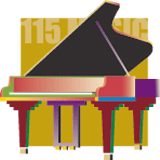Volume 24 · Number 2 · Spring 2008

Campus Views
The Beat Goes On
Students have been making music in 115 Music for decades, but the old lecture hall is too small, too noisy and about to be replaced.
Noon on a campus as big, busy and smart as this one can present regular denizens like me with a classic mind-body dilemma: expand cultural horizons or eat lunch. In that daily tug-of-war, my stomach trumps my brain nearly every time. Somehow, thoughts of food seem to erase all those well-meaning mental notes I’ve made to myself for lunchtime self-improvement: Catch an art exhibit, hear a lecture, check out a new book. I walk straight past at least three art galleries and two research libraries in my single-minded trek to the Coffee House. Sorry, no time for intellectual sustenance now. I’ve got a bowl of Vietnamese curry noodle soup to catch. If I don’t hurry, the bakery may run out of toffee bars.
But on Thursdays during the academic year — and, with increasing frequency, Tuesdays as well — the siren call of the Music Building is sometimes stronger than the magnetic pull of a Caesar salad with crispy romaine lettuce. That’s when music students, faculty and visiting artists give free noon concerts, performing a smorgasbord of music from Chopin piano pieces to Hindustani vocal works, from a Bach concerto to original works by UC Davis graduate students.
Ignoring any hunger pangs, I make my way to the Music Building and take a seat in that classroom-qua-stage known to thousands of students and alumni who have taken a music course during the past four decades — Room 115.
115 Music has been the venue for countless noon concerts since the Music Building opened in fall 1966. With its brown linoleum floors, white acoustical wall panels and bright fluorescent lighting, the room looks every bit its age — and its days as a chamber music venue are numbered. The music department has outgrown the 126-seat room and plans to build a bigger, better recital hall to replace it. But in the meantime, 115 Music carries on at an accelerating tempo — one of the campus’s most heavily scheduled classrooms.
During a series of fall-quarter-end recitals, music students, by turn, took their places in front of the room, like so many other students before them have done. And as they played, numerous other students in the audiences scribbled notes, just like their predecessors, for their music course assignments.
Some of that history is etched into the room itself, artifacts of countless class sessions and concerts. So many feet have walked up and down the steps to the tiered seating that the rubber stair edging is losing its tread.
Like the students, the musical instruments have left their mark. Sliding wood panels, which cover a whiteboard used in music courses, are striped black from the grand pianos that are wheeled back and forth for performances.
More than 30 campus music ensembles give a total of about 140 performances each year, many of them in 115 Music. But designed more for lectures than concerts, the room lacks a stage and dimmable lights and has acoustical problems that no amount of holey wall paneling can fix.
Bigger ensembles like the UC Davis Symphony Orchestra, the University Chorus and a new UC Davis Gamelan Ensemble perform in bigger venues — the Mondavi Center for the Performing Arts or the theatre and dance department’s Wright Hall. But those spaces are too big for chamber ensembles. This academic year for the first time, some noon recitals have been held in the Mondavi Center’s lobby.
With more than 3,000 students enrolled each year in music courses — hundreds of them music majors and minors — the two-story Music Building seems at times to be bursting with music. In nice weather, students’ practice sessions spill outside — delighting music-
loving passersby with the sounds of a classical guitar or a French horn but interrupting the work of other nearby departments.
That’s why the music department plans to build a 400-seat recital hall next door.
Bach, Mozart and Vivaldi surely never imagined a chamber like 115 Music when they composed the pieces performed there recently by some of the campus’s many chamber ensembles. But as a student string quartet began to play at a recent recital, I looked around the room and immediately recognized the look on the face of another woman in the audience — utter enchantment. It was the same feeling I was experiencing. I had forgotten all about lunch.
— Kathleen Holder
